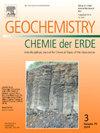沙特西部Harrat Hutaymah和Harrat Kishb新生代熔岩田地幔捕虏体中橄榄石示源化学及He同位素系统
IF 2.9
3区 地球科学
Q2 GEOCHEMISTRY & GEOPHYSICS
引用次数: 0
摘要
位于阿拉伯地盾西部的Harrat Hutaymah和Harrat Kishb新生代火山田的地幔捕虏体主要由原粒状橄榄岩、黑锌矿组成,少量含泥质和硅质岩。橄榄石的Mn、Ni和Ca含量相对于橄榄石(Fo)含量的变化与地幔残余橄榄石的变化相似,这些橄榄石是在暴露于源自地幔橄榄岩的低至中等程度熔融后结晶的。橄榄石中的Ca-Fe-Ni-Mg-Mn元素比值进一步表明橄榄岩的贡献。压力-温度计算和先前的地球化学研究表明,橄榄岩包体来自于阿拉伯地盾下地壳-地幔边界以下(地幔岩石圈~ 35km)。橄榄石3He/4He比值范围为6.1 ~ 8.5 Ra,与最近报道的离克拉通衍生的次大陆岩石圈地幔(SCLM)包体的<;7 ~ 9 Ra范围重叠,与该地区地幔一致。这就排除了来自阿法尔地幔样本的深部上升流地幔的流体/熔体对SCLM的叠加作用。然而,深层地幔流体的影响可能是隐蔽的,由于阿法尔地幔柱的He含量尚不清楚,因此值得进一步探索。本文章由计算机程序翻译,如有差异,请以英文原文为准。
Chemistry and He isotope systematics of olivine as tracers of source in mantle xenoliths from Harrat Hutaymah and Harrat Kishb Cenozoic lava fields, Western Saudi Arabia
Mantle xenoliths from the Cenozoic volcanic fields of Harrat Hutaymah and Harrat Kishb, located in the western part of the Arabian Shield, consist of proto-granular lherzolite, harzburgite, and to a lesser extent dunite and wehrlite. The olivine displays variations in Mn, Ni, and Ca contents relative to the forsterite (Fo) content that is similar to that of residual mantle olivine, which crystallized after being exposed to low to intermediate degrees of melt derived from mantle peridotite. The elemental ratios of Ca-Fe-Ni-Mg-Mn in the olivine further indicate a contribution from peridotite. Pressure-temperature calculations and previous geochemical studies indicate that the peridotite xenoliths were entrained from below the crust-mantle boundary (~35 km in the mantle lithosphere) under the Arabian Shield. Olivine 3He/4He ratios range from 6.1 to 8.5 Ra, which overlap the range of <7 to 9 Ra recently reported for off-craton-derived subcontinental lithospheric mantle (SCLM) xenoliths and is consistent with mantle beneath the region. This tends to rule out the overprinting of the SCLM by fluids/melts derived from the deep upwelling mantle sampled by the Afar plume. However, the influence of deep mantle fluid may be cryptic and warrants further exploration because the He content of the Afar mantle plume is unknown.
求助全文
通过发布文献求助,成功后即可免费获取论文全文。
去求助
来源期刊

Chemie Der Erde-Geochemistry
地学-地球化学与地球物理
CiteScore
7.10
自引率
0.00%
发文量
40
审稿时长
3.0 months
期刊介绍:
GEOCHEMISTRY was founded as Chemie der Erde 1914 in Jena, and, hence, is one of the oldest journals for geochemistry-related topics.
GEOCHEMISTRY (formerly Chemie der Erde / Geochemistry) publishes original research papers, short communications, reviews of selected topics, and high-class invited review articles addressed at broad geosciences audience. Publications dealing with interdisciplinary questions are particularly welcome. Young scientists are especially encouraged to submit their work. Contributions will be published exclusively in English. The journal, through very personalized consultation and its worldwide distribution, offers entry into the world of international scientific communication, and promotes interdisciplinary discussion on chemical problems in a broad spectrum of geosciences.
The following topics are covered by the expertise of the members of the editorial board (see below):
-cosmochemistry, meteoritics-
igneous, metamorphic, and sedimentary petrology-
volcanology-
low & high temperature geochemistry-
experimental - theoretical - field related studies-
mineralogy - crystallography-
environmental geosciences-
archaeometry
 求助内容:
求助内容: 应助结果提醒方式:
应助结果提醒方式:


